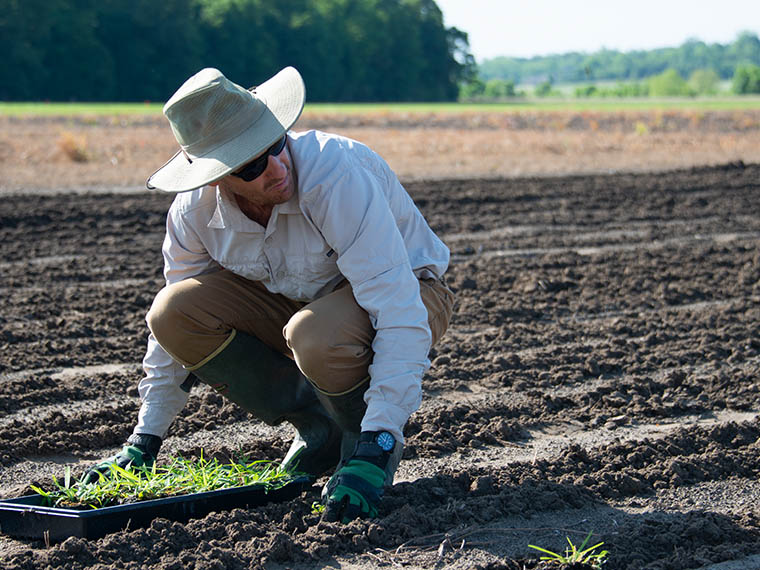The information presented on this page may be dated. It may refer to situations which have changed or people who are no longer affiliated with the university. It is archived as part of Mississippi State University's history.
The first plantings of the new MAFES Turfgrass Breeding Nursery are beginning to grow at the MAFES R.R. Foil Plant Science Research Center. The MSU turfgrass breeding program has installed 5,000 square feet of St. Augustine grass, which will be offered to sod producers throughout the region.
Dr. Eric Reasor, MAFES scientist and assistant professor specializing in turfgrass in the Department of Plant and Soil Sciences, said the breeding program will greatly benefit from the space. The breeding nursery or field is the first step in the turfgrass certification process. Ideally, the grasses developed here will be sent on to sod producers to be used to establish foundation or certified fields.
"The initial idea for a breeding nursery came from MAFES administration, who have been very supportive of this endeavor," Reasor said. "We began planning a year ago and put the first plugs in the ground this past May."
Reasor said the nursery encompasses six acres that has never been planted in turf.
"It's far away from turf so we can keep the material clean and pure. Hopefully, we can send this grass to sod producers so that they can then sell and grow as clean material."
Reasor said he hopes the nursery will one day serve the athletic department's turf needs as well.
"We hope to develop a method and protocol with this first grass that we can then apply to multiple grasses, hopefully even one day supplying sod for all of the athletic fields at Mississippi State," Reasor said.
Currently, the MSU breeding program is evaluating 110 to 120 grasses for athletic fields, golf courses, and home lawns. Reasor said the team is working with Brandon Hardin, MSU's sports turf superintendent and an alumnus of the program, testing five new bermudagrass cultivars on the MSU football team's practice field.
"We planted a trial on one of the practice fields and Brandon is implementing his management to see which varieties he likes best in terms of aesthetics and traffic tolerance," Reasor said.
While the team hopes to eventually get MSU turf back on Scott Field, this initial planting in the breeding nursery is geared toward sod farmers who ultimately serve homeowners looking to sod their lawns.
The breeding team planted 1,170 plugs of MSA 2-3-98 St. Augustine grass, which MSU marketing students tentatively named Silk St. Augustine grass. The grass was patented by MSU in the early 2000s. Wayne Philley developed the variety. The senior research associate in the Department of Plant and Soil Sciences has been a part of the turfgrass breeding program for nearly forty years.
"Currently, there is no St. Augustine grass grown by local producers. The St. Augustine grass you can sometimes purchase at a local retailer was likely grown in southern Alabama or North Florida and isn't completely adapted to the North Mississippi climate," Philley said.
Philley said St. Augustine grass, which is shade tolerant, is a good alternative to bermudagrass for shaded yards.
"This is a warm-season, shade-tolerant variety adapted for north and south Mississippi," Philley explained. "By developing this, we are giving our local producers the chance to provide a product well-suited for homeowners here."
The MSU turfgrass breeding program has plans to plant two of the breeding nursery's six acres by spring 2019. The breeding program is also a testing site for the National Turfgrass Evaluation Program, one of the most well-known turfgrass research programs in the world encompassing the evaluation of seventeen turfgrass species across 40 states and six Canadian provinces.

